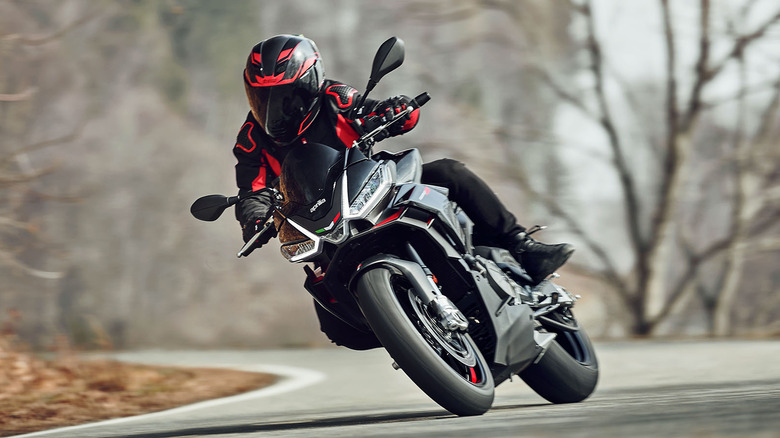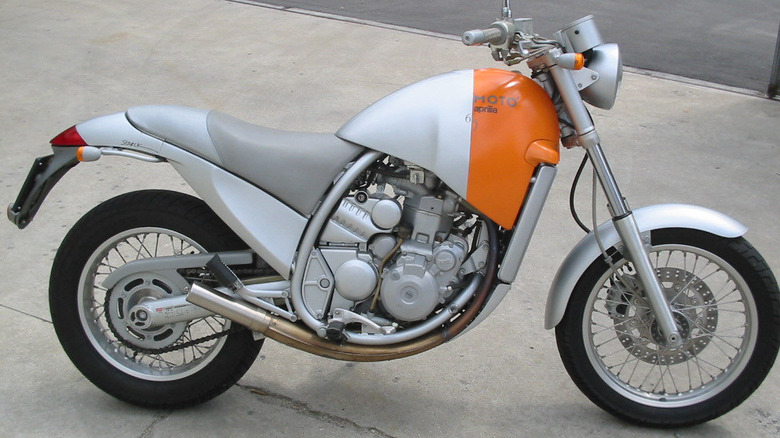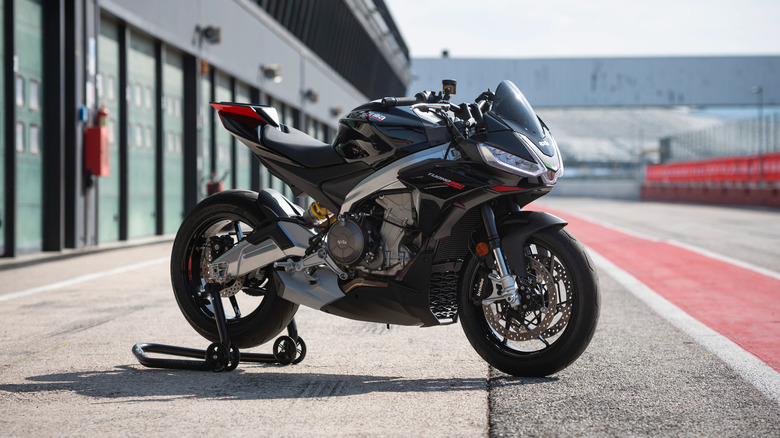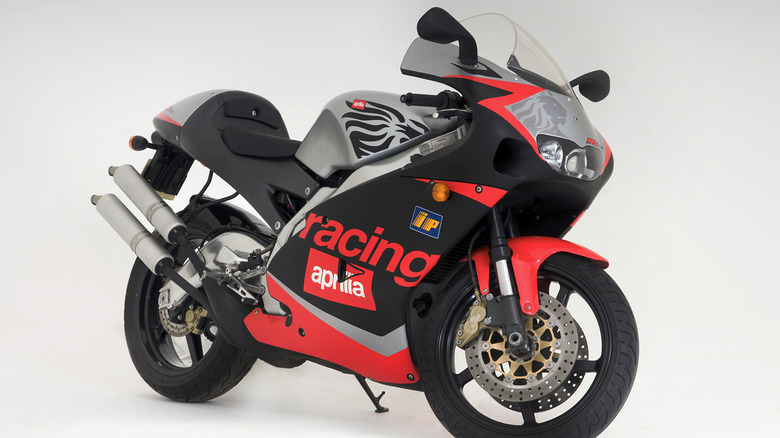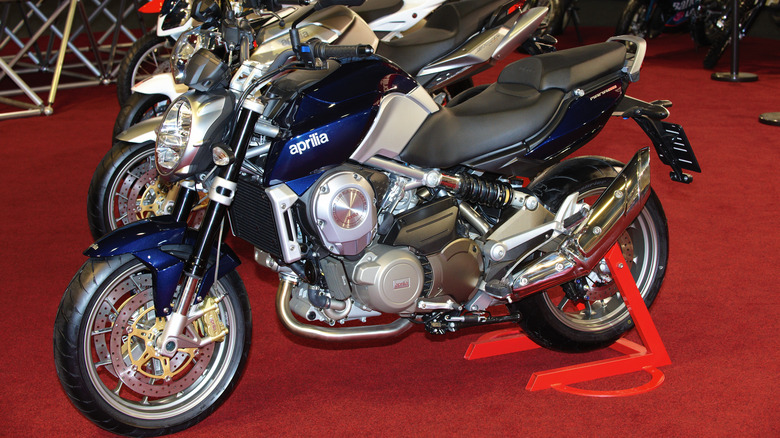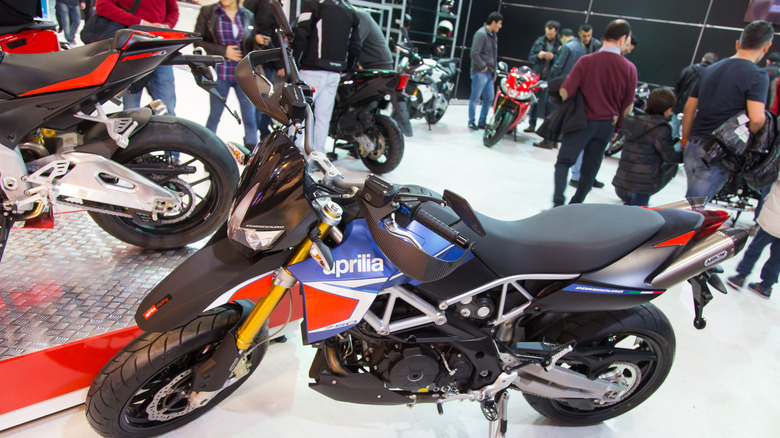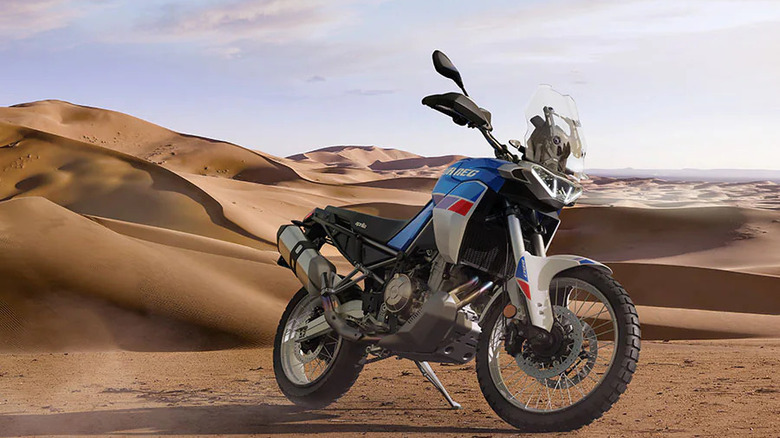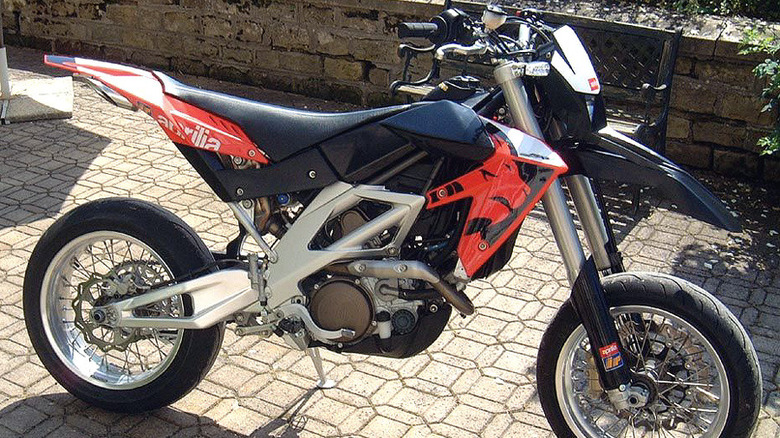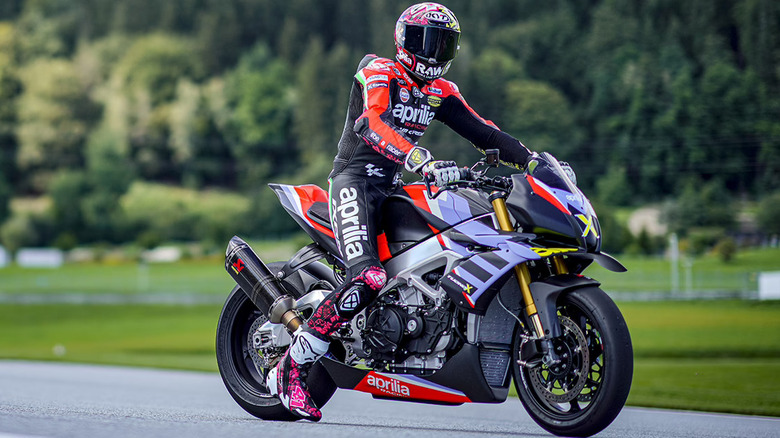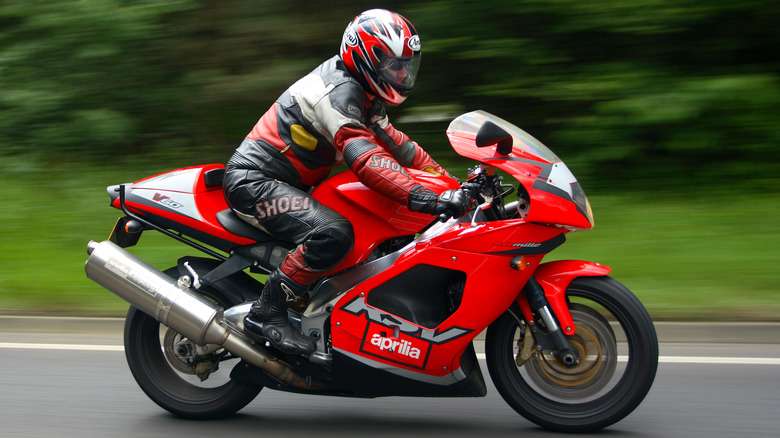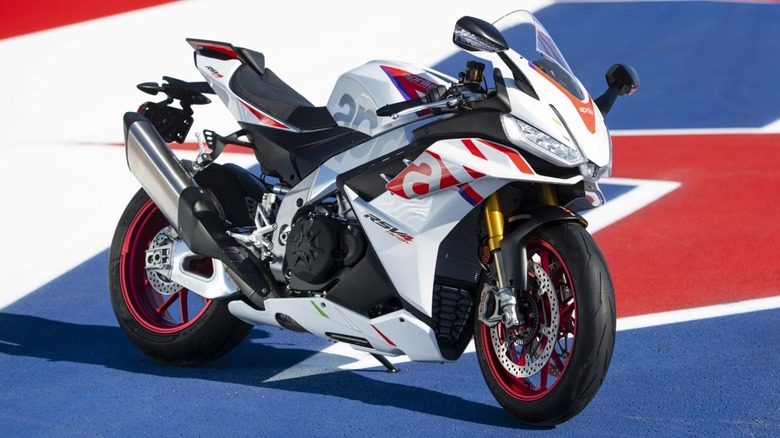10 Of The Best Aprilia Motorcycles Ever Made
When we think of Venice, Italy, our imagination may be drawn to gondoliers negotiating the Grand Canal, gelato in St. Mark's Square, or photo opportunities on the Rialto Bridge. Motorcycles rarely feature in these scenarios, yet the region is well known for producing one of Italy's most celebrated brands, Aprilia. While it may not be as deep-rooted as its compatriots, Moto Guzzi and Ducati, Aprilia has made a significant impact on the industry, especially within the dual-sport and sport bike segments.
Established as a bicycle company at the end of World War 2, Aprilia started manufacturing motorcycles around two decades later and has since enjoyed considerable success, both commercially and in motorsports. In fact, after introducing its first motocross bike in 1974, Aprilia took home its first championship titles just three years later in 125cc and 250cc classes, as production was buoyed by a successful line of motor scooters, numbering around 12,000 units annually.
While Aprilia's path to becoming a leading motorcycle manufacturer was relatively slow to gather pace, by the end of the century, it was producing liter-class sport bikes followed by supermotos in the early 2000s. At this point, Italian auto giant Piaggio took the company's reins (having also bought Moto Guzzi), and production snowballed. The following ten Aprilia motorcycles represent its most aspirational, competitive, and innovative models throughout the brand's storied history, which combine to paint a detailed picture of this somewhat unconventional marque.
Aprilia Moto 6.5
Few bikes can claim to have been exhibited at New York's Museum of Modern Art as this Philippe Starck-designed Moto can. While it never received much praise regarding performance and handling, it was notable for being a unique reimagining of a motorcycle's appearance, with its sweeping, curved chassis punctuated by angular lines, typical of the designer's style.
The Aprilia Moto 6.5 was polarizing among the biking community as motorcycle purists saw it as a pretentious statement rather than an everyday machine. Yet Philippe Starck himself is quoted as saying a motorcycle is an object of function and pleasure, and the objective observer might simply see this as an attempt to combine artistic flair with practical usage. In any case, the bike didn't fare so well in real-world testing, giving its critics plenty of fuel for their fire.
For a start, it was lacking in build quality. Its Rotax engine was lackluster, and its features and onboard equipment were as sparse as one of Starck's minimalist coffee tables. Still, as a commuter bike, the Moto 6.5 is a perfectly adept vehicle, with its nimble frame, high-profile tires, soft suspension, and upright riding position, making it perfect for navigating uneven roads and Milanese traffic.
While it is certainly no Aprilia RSV4 Factory, the Moto 6.5 represented a time when the company was starting to come out of its shell as a real contender among the ranks of its peers and gave us a taste of the innovative thinking and progressive machines that were to come.
[Featured image by Prattflora via Wikimedia Commons | Cropped and scaled | Public domain]
Aprilia Tuono 660 Factory
Fast forward to the Aprilia motorcycles of today, and in stark (or should that be "Starck"?) contrast to the Moto 6.5 is the Tuono 660 Factory. This is an excellent example of the modern Aprilia — a mid-size, finely-tuned sport bike that marries looks and performance with ride quality, resulting in a lightweight, nimble machine that will make the hairs on the back of your neck stand up.
The Tuono 660 Factory's aesthetics are immediately impressive, with its sculpted fuel tank and "naked" attributes, including a half-faring that leaves much of its workings on display. As a hybrid of the naked Tuono V4 1100 and the RS 660, it has the looks of the former and the technology and lightweight characteristics of the latter, making this a comprehensive ride comparable to the Ducati Monster in price and specs.
The features of the Tuono 660 Factory don't disappoint, with Ohlins electronic suspension, lean-sensitive traction control and ABS, and wheelie control, all of which contribute to better performance and handling. In keeping with the times, many of its functions can be controlled and relayed back to the rider via its smart TFT display.
The Aprilia Tuono 660 Factory is more than just a sum of its parts. Its name translates as Thunder, which seems fitting for a bike that, while smaller in engine capacity and power than many of its liter-class peers, provides the same acceleration, top speeds, and exhilarating performance as many of its more expensive counterparts.
Aprilia RS 250
Aprilia entered competitive motorsports around the mid-1970s and started coming up through the ranks in the fiercely competitive 250cc class. By the mid-1980s, it was a serious contender to the likes of dominant Japanese marques such as Honda and Yamaha. By 1994, they had a bike worthy of winning championships in the Aprilia RS 250.
The original racing bike, as ridden by Max Biaggi and a youthful Valentino Rossi, was a modified two-stroke Suzuki design that was a triumph on the race track. Despite its run of just ten years, it is revered to this day, having won its first world title with Biaggi at the throttle in its debut year.
What was so appealing about this small-capacity racer? To start, the Suzuki engine was incredibly reliable and powerful for its size. This was then optimized with tweaks to its cooling, ignition, and gearing, as well as its fiery two-stroke V-twin engine that left the bike bursting with vitality once you got it near the red. While it wouldn't be described as comfortable, its setup inspired confidence, buoyed by its Brembo four-piston disc brakes up front and upside-down forks, making this a favorite among professionals and amateurs alike.
This performance, coupled with an exciting rider experience and killer looks, made the Aprilia RS 250 a much-loved example within its class. As two-stroke motorcycles were consigned to history, parts became scarcer, and durability issues set in, this once-popular machine is much harder to come by and, as a result, will continue to appreciate in value as a classic of its time.
Aprilia Mana 850
As fossil-fueled vehicles are soon to be phased out in many countries around the globe, our familiar, geared motorcycles will gradually be replaced by automatic electric models. While this inevitability may be unwelcome news to some, automatic motorcycles have been around for some time, including the highly-popular Honda Africa Twin DCT and the now-discontinued Aprilia Mana 850.
The Mana 850 offered the best of both worlds, as it had a manual transmission that could be switched to an optional CVT (continuously variable transmission) as required. As anyone who cut their teeth on a scooter or ever had to endure dense traffic with a heavy clutch will attest, there is much to be said for twist-and-go functionality. Likewise, when you wish to head out of town and open up the throttle, the seven-speed manual transmission will satisfy the ardent gearheads among us at the flick of a switch.
Other features that added to the Mana 850's appeal included its under-seat fuel tank that allowed for storage space up front where it usually resides, a charging socket, and an 839cc V-twin engine that was more than capable. It begs the question as to why this practical, versatile machine came to be discontinued in 2011, and this is a question Honda may have asked as it recently produced the similarly-specced NC750X DCT automatic, with many of the same attributes as its Italian predecessor.
Aprilia Dorsoduro 750
What happens when you take a high-powered dirt bike, upgrade the brakes and suspension, and add slick tires? You get a street-savvy road rocket known as the supermoto, and while this is a relatively niche segment, it produces some great machines like the KTM 990 Supermoto R and Ducati Hypermotard 950 S. The Aprilia Dorsoduro 750 was one such machine that was just as good as any of its contemporaries and as much fun to ride.
At first glance, the Dorsoduro looked a little intimidating, with its over 34-inch seat height, long travel suspension, sporty 17-inch wheels, and compact trellis frame that housed a considerable 749cc engine. It suggested significant potential, like a coiled spring, and by most accounts, that's precisely what it delivered. Equally at home in the city or on the track, the bike came into its own when thrown through tight twisties due to its excellent handling, light frame, and high riding position. It was characterized by its twin exhausts which were tucked, racing style, up under the seat, and aggressively styled-jagged faring.
Beyond its looks and performance, the Dorsoduro 750 had plenty of fittings and features to keep you entertained. These included its preload-adjustable front and rear suspension, multiple switchable riding modes, and a toggled LCD that displayed plenty of useful data, including lap times and maximum speed, as well as an odometer, speed, temperature, and trip journal. It has since been updated as the Dorsoduro 900, which is a formidable motorcycle in its own right, but it was the much-loved original that deserves a place among the ranks of Aprilia's best motorcycles.
Aprilia Tuareg 660
Adventure motorcycles have found a firm footing since the turn of the century among bikers that wish to go off the beaten path. Unlike the other European brands that dominate this segment, BMW and KTM, Aprilia currently has only one model within the ADV category. However, with the mid-size Tuareg 660, they made sure it's an absolute stunner.
The Tuareg is by no means a new concept from Aprilia, having released the first model in 1985, and the latest design shares some features with its ancestor, such as the half-cowling, double headlamps, and long single seat. However, a lot has changed in the intervening years, and the Tuareg of today is a different beast entirely. From the tubeless tires up, it looks and behaves like a grade-A adventure bike should, with a native frame and suspension, wire wheels, 80-horsepower, 659cc parallel-twin engine, large upswept exhaust, and skid plate as standard.
The Tuareg 660 has a seat height of under 34 inches despite a ground clearance of almost 10 inches and it weighs just 450 pounds when fueled. As you might expect from such a well-equipped bike, the Tuareg 660 features a five-inch TFT display that enables tweaks to its traction control and ABS while also presenting the usual essential data, including gear selection and riding mode indicators.
This is a forward-thinking machine with solid roots in the past and a worthy rival to its impressive competition, which includes the Triumph Tiger Sport 660 and the new Honda Transalp.
Aprilia SXV550
While TFT displays, large windshields, and heated hand grips are all well and good, sometimes you require a bike that strips everything down to the bare essentials and provides a fully-immersive riding experience, from the footpegs to the handlebars. As a 549cc supermoto, the Aprilia SXV550 was a race-bred road bike that was far from practical, yet it was so much fun to ride that it earned itself legions of fans thanks to its feisty engine and blistering performance.
There is no doubt that the SXV550 came from good stock, as its smaller cousin, the SXV450, had previously won the S2 Supermoto World Championship while still in its prototype stage. The engine was a masterpiece of design, with its 77-degree V-twin that eliminated vibration, delivering a silky-smooth performance even in the higher rev ranges. This orientation also meant it was light and compact for its engine capacity, facilitating a nimble ride while delivering incredible power.
While the Aprilia SXV550 did include two-stage mapping to tune your ride to the road conditions, this was ultimately a minimalist rocket that, in all fairness, was just a little bit silly, in the best sense of the word. Maybe the good folks at Aprilla realized this, as it was pulled from production after an all-too-brief six-year tenure – but what a glorious few years it was.
[Featured image by StealthFX via Wikimedia Commons | Cropped and scaled | Public domain]
Aprilia Tuono V4 X
While Ducati has produced some stunning-looking sport bikes over the years, Aprilia has lately been giving it a run for its money, with one shining example being the Tuono V4 X. However, the marque has achieved so much more with this thoroughbred racer that one can almost forget the aesthetics altogether, as it is a comfortable, high-handlebar, high-performance machine that is at once aspirational and accessible for riders of many skill sets.
The Aprilia Tuono V4 X is a hypernaked model that bares all with its half-fared body and exposed workings. Yet this is much more than a design feature, as every aspect is carefully considered to ensure this is one of the most lightweight and powerful bikes within its segment. The 1,077cc V4 engine is the same tried-and-true Aprilia Racing model behind seven World SBK championships, and it produces more than 200 horsepower for those with the nerve to test it to its limits.
Somewhat unsurprisingly, the Tuono V4 X is sold as a numbered, limited edition, as it should be. After all, some things ought to remain sacred, and anyone with dreams of taming one of these beasts can always settle for the excellent and more reasonably-priced Tuono V4 Factory, which is guaranteed not to disappoint and makes a worthy compromise.
Aprilia RSV Mille
Aprilia came to the forefront of competitive motorsports with two highly successful models, namely its RS 125 and the previously-mentioned RS 250. However, having cut its racing teeth with smaller capacity sport bikes, Aprilia seemed unhappy to rest on its laurels and was soon to join the ranks of liter-class racers with this impressive 1998 offering that is still often talked about over twenty years since its discontinuation.
Much of the RSV Mille's success can be attributed to its namesake 998cc engine. The Rotax-designed power unit was a fuel-injected, 60-degree V-twin that was lightweight, compact, and produced 115 horsepower. This was then encased in a smart aluminum frame and aerodynamic, sculpted faring, balanced on Showa forks and a Sachs mono-shock, given a little spit and polish, and released upon the late-1990s masses.
Despite being a first outing for Aprilia among the ranks of its more experienced Japanese and homegrown competition, the Mille proved to be an astounding debut. It might be a little clunky in the lower rev ranges, but as soon as you opened the throttle, the bike performed like a true purebred racer. It was also built very well, with strong reliability ratings, and was even produced in a racing homologation version for the World Superbike Championship.
Perhaps most importantly, this was the bike that brought Aprilia into the fold among the big leagues of sport bike manufacturers. While the company had been highly impressive in the competitive 125cc and 250cc racing classes, the Aprilia RSV Mille heralded a new era of high-capacity, high-performance motorcycles for Aprilia as the first in the much-lauded RSV family of bikes.
Aprilia RSV4 Factory
After the success of the RSV Mille, Aprilia continued to build upon its legacy with the next-generation RSV4 line of high-performance motorcycles. Although the model has been in production since 2010, the latest edition Aprilia RSV4 Factory is arguably the best yet, as over a decade of research and development has contributed to its evolution. This 217 horsepower machine is a road-ready racer that allows mere mortals to experience MotoGP levels of performance, provided they have the requisite skills and a watertight health insurance policy in place.
While its top speed is capped at 189 miles per hour by killjoy Euro 5 restrictions, it can nonetheless accelerate to 60 miles per hour in a blistering 3.2 seconds and perform a standing quarter mile in 10.4 seconds. This performance is further embellished by a fully adjustable electronic suspension system, which has a choice of semi-active and manual modes. Its aerodynamics are cleverly concealed within its faring to provide downforce without necessitating spoilers, and it still affords a relatively comfortable and immersive rider experience consistent with the RSV range.
While some owners have reported mechanical issues with the Aprilia RSV4 Factory, this is often a feature with delicate thoroughbred machines, just as your pedigree Weimaraner might require more trips to the vet than your Labrador-Spaniel cross. Above all else, it is a motorcycle born for speed and a fitting tribute to the considerable effort Aprilia has put into honing its craft as a dominant force on the racing circuit, which is set to continue for many years to come.
